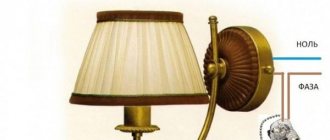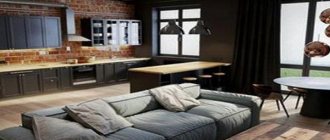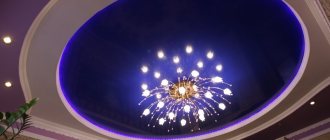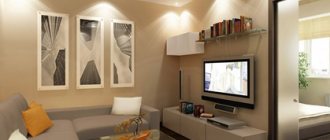Species and types
To choose lamps for the attic, first pay attention to their classification. You can match your original preferences and organize a small space as in the photo.
However, keep in mind that in the photo the area may be visually enlarged.
The quality of lighting depends on the type of lamps installed. For a relaxation area, for example, you need to use dim lighting, and for an active work area, vice versa.
Standardly, all lamps regarding the method of their installation and placement on the floor are:
- Local. They are installed locally, without connecting to each other. These include individual floor lamps, sconces and other spotlights. They are especially often used after the construction of the house, so as not to resume deep work with electrical wiring.
- Full. They apply to the entire house and are planned in advance. For the attic, chandeliers transform the floor into a full-fledged work and living attic space that is comfortable to use at any time. However, it is not always possible to attach chandeliers in the attic, which is why the first option is used.
Locals come in different types, since the way they are attached differs:
- Floor-standing. A simple option that can be conveniently rearranged for zoning the attic floor.
- Wall-mounted. You can attach the lights to the wall, which is more often used for a work or reading area.
- Built-in. The set can be equipped with lanterns that will create a multi-level lighting system for the room.
The type is selected based on the preferences of the residents regarding the use of the attic area. To do this, you can look at photo examples of installing lighting fixtures so that they match the interior of the house and correspond to the functionality.
Devices for supplying light in the attic
To use the floor, you can consider a photo design that you can apply to your home. However, for this, consider your convenience and the purpose of using lighting on the upper floor.
Lighting in the attic is selected from five options:
- Spot lights. They are distributed along the ceiling and can be connected to different switches. This contributes to space zoning and a multi-level lighting system.
- Diode tape. The ribbon can also be used as decoration. It is usually placed on the floor, furniture or ceiling to create a cozy atmosphere with dim lighting, as in the photo.
- Neon lights. Recessed ceiling lights gently illuminate the selected area and are suitable for illuminating attics with sloping walls.
- Local flashlights. These include bedside lamps, sconces, and floor lamps. You can install several elements to zone the space in the evening.
- Diffuser. Used less frequently, but creates the effect of a starry sky on the ceiling or other non-flickering pattern. The lighting can be used as a night light.
Different devices contribute to adding different degrees of illumination to the attic part of the house, so a house with an attic and a second light often needs to be designed in advance. However, adding high quality appliances will help create a cozy room that can be used on a regular basis.
Types and types of attic lighting
Lighting fixtures in the attic area can be classified into several types. There are options for local and full area lighting. Sources of local lighting in the attic area are used most often, these include:
- Sconces and models of wall lighting sources;
- Ceiling and wall spots;
- Floor lamps;
- Floor, table and portable types of lamps;
- Spot ceiling lighting devices.
Attic lighting using point light sources is not always appropriate to use to create light throughout the entire area. For example, it is better to use sconces and point forms around the perimeter, and place a chandelier or large lamp in the center. Several floor lamps mounted in the corners visually increase the size of the room, emphasize the lines of the rooms and highlight the arrangement of furniture. Categories of general lighting are used not only on the attic floors, but throughout the house. The light from them is more diffused and spreads throughout the entire territory. This group includes the usual chandeliers. When choosing general lighting, it is recommended to install chandeliers in a single copy, regardless of the number of lamps and their power.
Artificial lighting
To achieve different results, designers often use only natural lighting, which makes it possible to use the attic only during daylight hours. This is done with a sloping ceiling when installing additional windows and standard side windows on it.
However, most often it is not rational to use only natural light, since on cloudy days or in winter there will be quite a bit of light reaching the attic floor. This will make it difficult to work there during this time.
To minimize artificial lighting, you can choose background lighting in the form of lamps built into multi-level ceilings, as in the photo.
Additionally, you can select local lamps - sconces, floor lamps, spotlights. They contribute to zoning the area and highlighting work areas.
Choosing lamps for the attic
In order to properly organize the lighting of the attic floor in a private house, it is recommended to pay attention to the choice of lighting fixtures. The high quality of the lamp contributes to the complete creation of a working environment under the roof.
To select lamps for installation in the attic floor, consider the following factors:
- The area should have as much light as possible. The rules apply as much as possible to daylight hours, so you need to install upper windows. To increase the amount of light, you can install a large mirror opposite them.
- For the attic it is better to choose a light design, as in the photo
- For it, select light lamps - preferably with a white or light shade of light. This way you will visually expand the space.
- When choosing a floor lamp, it is better to choose a floor lamp with a high leg. It is recommended to install them in the corners of the room to visually enlarge the attic floor.
- To create a work environment, install cool lighting. For this purpose, fluorescent lamps are installed.
- To create a semblance of natural daylight, you can install tungsten-halogen light bulbs; they will help create a cozy atmosphere on the attic floor.
Consider the difference between local lighting for the attic floor and full lighting. The first cannot completely illuminate the space so that it can be actively used at night or in the evening, when natural light will not enter the room.
Basic rules for choosing lamps
- In this area, high-quality lighting is very important, which means a large number of lamps are needed. Don’t forget also about backlit furniture and walls; they need to be taken into account when choosing lamps.
- To make the attic floor look impressive, the glow of spotlights or LED strips must be directed at the wall, thereby visually enlarging the room.
- When installing lamps around the perimeter, the room will become visually larger. To maximize the size of the attic, it is worth installing a large mirror.
- Both halogen and LED lamps are used. Both options are good, but their glow is different. Lamps are selected based on the owner’s preferences.
- The style of lighting fixtures itself is chosen depending on the existing decor. It is important that everything looks harmonious.
- When calculating the light power, you should not take into account the light from the windows, since it will be absent at night.
Today, the abundance of methods and types of lighting is impressive. You can illuminate the attic both locally and by zone. Let's consider the types and types of attic lighting:
- wall and using sconces;
- spots on the ceiling and walls;
- portable, floor types of lamps;
- spotlights.
Lighting the attic with spotlights is not always convenient, since the light is not local. They are often combined with other types, for example, spotlights are installed around the perimeter, and a chandelier or large lamp is installed in the center. To emphasize all the advantages, place several floor lamps in the corners. General lighting is applicable not only in the attic, but throughout the house. It gives a more diffused light flux. It is recommended to use only one chandelier per room with an unlimited number of lamps.
Options for placing lamps in the attic room
There are several ways to install lamps that will create the effect of full illumination of a floor with a sloping roof:
- Hanging structure. You can build a special mount that is installed based on both bevels. It looks cumbersome, but it provides good lighting in the attic.
- If the ceiling is not completely slanted, then a chandelier can be installed on the part parallel to the floor for full illumination. However, if it is close to the corner of the room, then it will not be possible to create full illumination of the attic floor, so you will have to attach additional devices.
- You can use beams to secure chandeliers for the attic, since a sloping ceiling often consists of several similar beams. You can attach one or more small lamps to them.
This makes it nearly impossible to attach standard overhead chandeliers for full illumination. In addition, most often ceilings are replaced with windows for additional natural light.
The main feature of the attic under the roof is the roof with a slope as in the photo.
If more than one method cannot be done, it is better to use local devices that are evenly distributed throughout the room. The main thing is to pay attention to the areas where you plan to work in the evening to ensure that this area is fully illuminated.
You can arrange the lamps either in one level, or create a multi-level system in which the upper chandeliers and spotlights are combined with spotlights. Focus on the work area (desk) and the area near the bed for reading (bedside sconces), and it is better to leave the relaxation area with dim lighting. To do this, use a diode strip.
Chandeliers for sloping rooms on the attic floor
Such devices are traditionally used as general lighting. But hanging them on a sloping ceiling is difficult - the chandelier will tilt at an angle to the floor, which looks strange. There are several options to solve this problem.
In many attics, not the entire ceiling is sloping; part of it remains flat. This is where the lamp is attached. It is good if the flat surface is in the middle of the room (this happens in small dachas). Otherwise, the lighting will be uneven and additional lamps will be needed.
Often there are attic rooms with exposed beams. Then the chandelier is hung directly on one of them. Due to the fact that the wire will be close to the tree, you will need to take precautions. To prevent a fire, do not secure the cable with metal clamps. It’s better to put it in a plastic tube of such a diameter that there is free space around the wire.
If the entire ceiling surface is sloping, you can use flat LED lighting fixtures. Such products are round, square or rectangular, are easy to attach and save energy.
Another option for a chandelier suitable for an attic ceiling is a model with a movable suspension. The tire is bent so that the lampshade is level.
You can also use a regular chandelier, but then the decorative cap will not completely hide the mount. It will look less aesthetically pleasing.
An interesting solution is produced under the NaBrevno brand. This is an overlay that allows you to hang a regular chandelier on an attic ceiling.
The device is a beveled cylinder with a drilled hole for the wire, to which the base of the lamp is attached. The cover is made of wood: oak with a copper tube inside or pine with a plastic insert. The bevel angle is selected depending on the slope of the ceiling, and the size - on the diameter of the protective cap of the chandelier.
If you have woodworking skills, you can make such an overlay yourself.
The chandelier creates a comfortable homely atmosphere in the attic. But the overall height of the room is reduced, especially with a model with a long suspension. If there is less than 2-2.2 m below, the room will become uncomfortable. In this case, it is better to consider other lighting options.
What lighting is best for a sloping attic?
The type of attic lighting that is created for the convenience of using the attic depends on its characteristics. There are two options: either you use it as a bedroom, or a creative space for permanent work. In the first case, you need to use dim light, and in the second, you need to fully illuminate individual areas.
Let's look at both options:
- For the sleeping floor, use LED lighting or special strips that are evenly distributed throughout the room, creating a subdued atmosphere. You can use separate point devices (for example, at the bedside for reading).
- For a creative room, it is better to choose brighter elements. To do this, a roof with a second light is made from the inside. The multi-level system helps to divide the degree of illumination of the room. For this purpose, a common chandelier and additional local lamps are installed.
The more lighting on the attic floor, the larger the attic will visually appear. To do this, you can look at the photo of the attic design so that the added light matches the interior. However, keep in mind that the light may appear brighter in the photo.
Installation of electrical equipment in the attic area: advice from professionals
After selecting the devices and clarifying their design from the photo, begin wiring. In a wooden house, wiring must be done carefully, as electrical appliances can cause a fire. Because of this, attention should be paid to the safety of repairs and the quality of fastening of electrical wiring.
During repairs, follow the advice of the experts:
- Metal brackets cannot be used to secure lamps to a wooden surface. They can create minor damage that allows moisture to enter your home.
- Use electrical wiring protection in the form of a plastic tube. As in the photo, it does not look very bulky, but it will prevent emergency situations associated with a short circuit.
- It is better to use multi-core cables, as they have increased wear resistance. This will not deteriorate the illumination, but securing the devices is safe.
It is recommended to call a specialist to install the devices. This way you will prevent the negative consequences that will follow from poor fastening of the elements.
Despite the incomplete use of the attic floor, you should carefully consider the installation of lighting.
Electrical wiring in the attic area
Attic lighting includes not only the choice of light bulbs and lighting fixtures, but also the correct installation of electrical cables. Regardless of the building materials from which the house is built, the attic is often made of wood and insulated with various thermal insulation products. Even properly installed electrical wires become hot and can become a fire hazard. For this reason, when laying electrical cables in the attic area, contact specialists.
Before doing this, decide where the furniture will be, in what places the sockets and various appliances will be located. Think in advance about an option in which the furniture will be rearranged in the future.
To lay electrical transmission lines, take a three-core conductor. It is strictly forbidden to attach electrical wiring to the bare surface of wooden houses, since such fastening will lead to damage to the protective layer in the future, and also ignores the requirements for the gap between the cable and the base. Hidden wiring involves the use of a casing or a special box.
Important! In the attic, it is best to avoid installing a distribution box - route from the electrical panel of the house through universal linings.
Lighting of the work area on the attic floor
The area is often used to create a work or creative area. However, to do this, pay attention to its illumination so that you feel comfortable working there without harming your eyesight.
However, you won’t be able to work for long in a small room with sloping ceilings. But to reduce this factor, white light is used. The best option is multi-level lighting, which includes both full-fledged chandeliers and spotlights.
In the photo you can see an example of the use of the attic floor. But keep in mind that a photo is only an option for its use, which is not always convenient if you are constantly there.
Organization of lighting of the attic floor
It should be immediately noted that if the rooms in the attic are made standard and do not have sloping ceilings, then lamps can be installed according to the general requirements. But if the premises have inclined surfaces, it is worth considering several recommendations:
- Massive chandeliers and other similar options are ineffective because they do not provide normal illumination. They are not suitable for a corner ceiling and clutter up the space, which is unacceptable.
- It is better to use a large number of lamps and place them around the perimeter. It is important to be able to adjust the direction of the light and its brightness to ensure comfortable lighting.
Adjustable lights are a great option for the attic. - Decorative lighting is appropriate, which will visually expand the space and focus attention on the right areas. Options that highlight the contours of the room or window openings are also suitable.
- To create the effect of enlarging a room, it is worth using reflected light when the flow is directed towards a wall or sloping ceiling.
- When choosing, the style of the room’s decoration is taken into account, so you need to think about this point in advance.
By the way! Combined light is perfect for the attic floor, when different types of equipment are combined.
Cinema lighting in the attic area
Often, the space that remains under the roof is used by home owners to create a home theater. There are many photo ideas that present similar solutions. However, photography rarely fails to take into account the quality of lighting.
If there are windows, you need to make sure there are curtains that can block the access of light if you want to watch a movie during daylight hours. You should not use general lamps - it is better to choose spotlights that accentuate the area where the equipment is installed.
A common solution used in a home theater is a built-in background light on the ceiling, as in the photo.
It's better when you can change its saturation and colors. This way you can create the mood of the attic floor for watching a movie.
Light in an attic-type children's room
Using the attic floor as a children's room is a common solution that creates a separate space that the child can organize himself. It will help develop the child’s independence, but it is recommended to first select the quality of illumination of the area.
There are several points to consider when renovating:
- The children's room should have the maximum amount of light. This is necessary for the convenience of the child and to prevent damage to vision due to low quality lighting.
- You can use additional decorative elements that will add light to the room, as in the photo.
To do this, you can use night lights or small lamps in various shapes - the sun, the moon, or ordinary geometric shapes of bright colors. - If the child is studying, near the table for completing assignments, you need to install light sources, the saturation of which can be adjusted. This will help adjust the brightness level to make it more comfortable for your child to study without eye strain. The direction must be changed to point the bulb towards the task area.
- When installing a bunk bed, you need to install bedside lamps for each of the children.
When renovating, it is recommended to zoning the area in advance. To do this, find out where the play area will be, where the sleeping area will be, and where the study area will be. To do this, dim lighting is installed in the sleeping area, which will not interfere with children’s sleep. And in the study area, be aware of the presence of cabinets and shelves for educational materials, which may interfere with the penetration of light.
Take care of installing night lights first. To do this, you need to make sockets near the bed so that a small amount of light remains in the room at night.
However, be careful when installing sockets and appliances near the bed. Pay attention to their quality and take into account the age of the child to prevent possible risks associated with easily accessible electrical parts.
Safety rules for attic lighting in a children's room
To secure the attic floor for the children's room in it, you need to take into account the safety rules. You will be able to rationally use the attic space, in which you can constantly spend time without harm to your eyesight and health.
The wooden part of the house in direct contact with electrical wiring can lead to a fire, so be sure to use plastic covers for the wires.
You need to choose the quality of the lamps. Due to active games in the children's room, especially games with a ball, there is a chance that devices with glass or crystal equipment will break. To reduce the risk, first select unbreakable structures that cannot be damaged by accidental contact by children.
Be careful when equipping a room for an infant or just a small child - you should not make too bright accents. Interior, as in the photo
should have muted shades, and lighting should be uniform. Otherwise, the child will constantly look at the parts that stand out, which is why there is a risk of damage and eye strain.
Photos of the best attic lighting ideas
To choose the design of the attic floor, you can look at similar photos, so you can choose an option that looks impressive in the daytime and in the evening.
However, when viewing photos, always compare and find out the area of the room. Photos often visually increase the size of the attic floor, which is why many details in real life can look inorganic.
Choose the method of placing lamps based on the capabilities and type of internal structure. You will bring the result closer to the convenient practical use of the attic floor by distributing lamps on the floor.
Pay attention to the lighting recessed into the ceiling in the photo. It can’t always be done in the attic, but it looks impressive and creates a cozy backdrop.
Attic lighting is a difficult issue, which often finds only one solution - installing point elements such as sconces, floor lamps, wall lamps. However, there are many other ways to create cozy multi-level or single-level lighting that is comfortable to use on a daily basis. The quality and degree of placement of lamps depends on desire, so you can choose any option for their placement.










